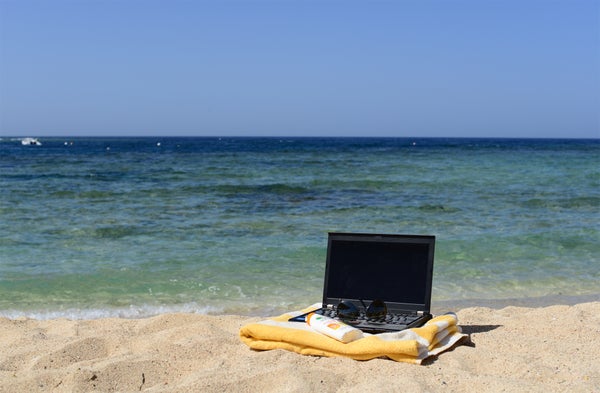This article was published in Scientific American’s former blog network and reflects the views of the author, not necessarily those of Scientific American
This post is part of the Workplace Anthropology series.
It's 10:30 PM on a Sunday night. I've finished folding our laundry and just started the dishwasher. As on most Sundays, S and I just finished watching The Walking Dead. Although while he was fully focused on the plight of the characters, I did what I normally do: half listened while I scanned work emails and went over my meeting schedule for Monday.
The idea of a standard workday began to take root during the American Industrial Revolution, when more people moved away from agricultural jobs and looked to factories for employment. While we might complain of having had a "long" day today, early factory workers had workdays that ranged anywhere between 10 - 16 hours six days a week. This practice persisted into the early 20th-century; workdays varied across industries and were set by the employer until the eight-hour-day was won by different union groups for their trades. Their efforts were aided by the dire state of the country during the Great Depression: In 1933 in an effort to jump start the economy, FDR sought the means to regulate industry and passed the National Industrial Recovery Act. Believing that unchecked competition had helped create conditions that led to the Great Depression, Roosevelt sought limited regulation, support for trade groups, and worker's rights (shorter working hours, better working conditions, minimum pay rates, etc.) He believed that these items would help pull the country out of the downward slide that threatened to persist indefinitely if left unchecked.
On supporting science journalism
If you're enjoying this article, consider supporting our award-winning journalism by subscribing. By purchasing a subscription you are helping to ensure the future of impactful stories about the discoveries and ideas shaping our world today.
This idea of 40 hours distributed over five days—with a fixed starting and stopping time—became a standard around which we organized our lives. For years, millions of Americans, got up in the morning and traveled to their workplace for a stretch of eight or nine hours and then traveled home. Work activities occupied a clearly separate sphere from home and leisure activities. However, in recent years, as the workforce and its needs have changed:
There are more women in the workforce.
There are more single parents and dual-earners in the workforce.
A greater number of Americans are caring for older loved ones.
As work and home have begun to overlap, there has been an increasing need for flexibility, which has changed the standard of an eight hour day. People no longer need to travel to an office; now they can work from home—or while on vacation or in between parent-teacher meetings or school play intermissions. Technology, of course, has been viewed as a means of facilitating this need. With access to email on-the-go and the means to take conference calls and share documents, the luxury of "working from home" allows workers to better manage their time on their own terms to a certain degree.
This freedom is also significant to Millennials, who are sitting at the crux of a cultural shift regarding creativity. There have never been more opportunities to pursue creative goals and collaborate with a diverse spectrum of people than there is today. Between online research tools, software, and social networking platforms, creative pursuits are a mainstay of our identities rather than a peripheral interest. Flexible work arrangements encourage these activities by allowing individuals the means to work from anywhere, which theoretically allows them to better juggle personal pursuits and needs while performing the tasks tied to their jobs.
The shift to this model has been gradual and not without its challengers. Critics often cite reduced face-to-face contact as a barrier to open communication and collaboration and question the truth behind claims of increased productivity. But as we adopt and grow more comfortable with the technology that allow us to connect with one another—whether that's email or collaborative software—the new standard increasingly breaks the mold of the eight hour day.
With the freedom to work from anywhere comes the anxiety of always needing to seem as though we are working. So we jump when our phones buzz to indicate an incoming email or we "check-in" on our day off under the pretense of not falling behind when what we're actually concerned about is not appearing to work. The impact here is that we're drawn increasingly into work and spend less of our time physically interacting with others; we may spend less of our time with each other actually speaking with each other. Work encroaches on the spaces that were formerly private and personal. I don't think I'm alone in having had my laptop open while sitting on the couch—a space that lends itself to more open interaction. Some people may bring work to the dinner table or even to the bedroom. Slowly but surely work has begun to follow us everywhere. If left unchecked, this can negatively impact our relationships; and here again we turn to technology to help mediate. While we're always "on," we're also plugged into social networking platforms and instant messaging channels that allow us to communicate with loved ones and "check-in" in reverse: during our workday (and sometimes from different rooms in our home).
Work-life balance seems increasingly to be an antiquated idea. Instead, we're looking at a seamless merger of work and life. Are you finding that 9-to-5 workday bleeds beyond eight hours? How are you finding balance when the new normal seems to be integration?
Have something to say? Comments have been disabled on Anthropology in Practice, but you can always join the community on Facebook.
